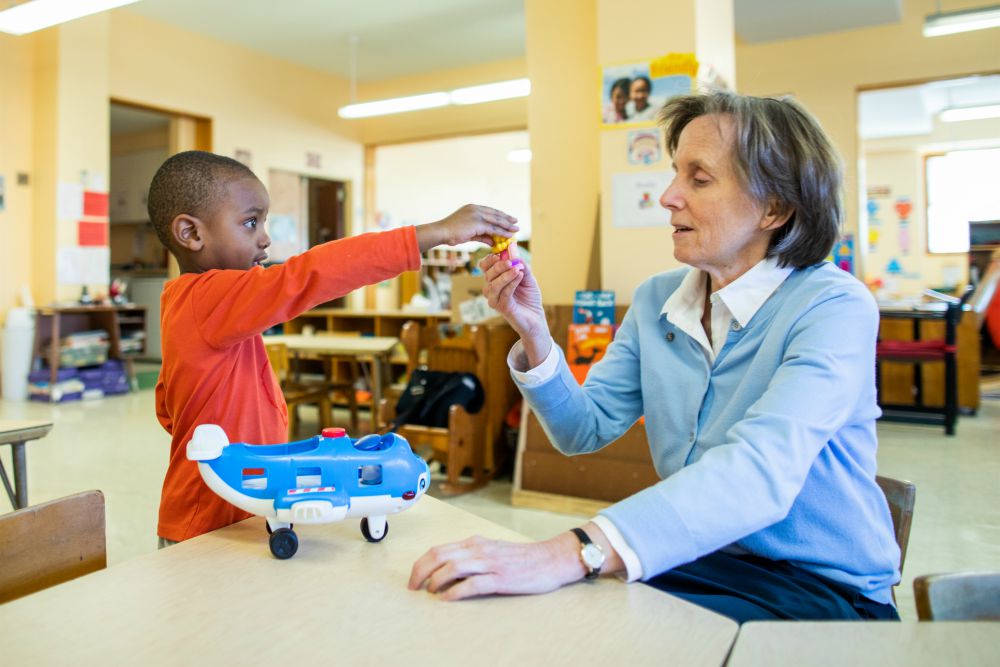
Daughter of Charity Sr. Mary Bader, right, plays with a young, airplane-loving friend at St. Ann's Center for Children, Youth and Families in Hyattsville, Maryland. (© Maureen Porto Photography/Courtesy of St. Ann's Center)
When Daughter of Charity Sr. Mary Bader looks out over the Washington, D.C., skyline from across the Potomac River in Virginia, what draws her attention are not the national monuments or U.S. Capitol building — symbols of national power and politics the capital city is well known for. What she sees are cranes. "Crane after crane after crane" — towering symbols of construction and, to Bader, growing inequality in the region.
Bader has led St. Ann's Center for Children, Youth and Families as its CEO for 11 years. Under her leadership, St. Ann's and its two-building complex in Hyattsville, Maryland — just across the street from Washington, D.C., but within the archdiocese — have gone through a few extensive changes.
In 2013, Bader and her team recognized that the D.C.-area was in a state of flux. "We looked to the community to see where the greatest need was," she said. With cost of living and family homelessness both on the rise, they decided to renovate St. Ann's main building to open "Hope House" — a brand new transitional housing facility with 15-18 living units for single mothers experiencing homelessness.
Despite shifts in its approach, St. Ann's, which was founded in 1860 by the Daughters of Charity, has remained committed to its 159-year-old mission to care for some of the area's most vulnerable women and children.
"[These families] are an inspiration," said Bader. "They are a gift to St. Ann's."
Dedication to cause and adaptability in a changing landscape are not qualities specifically unique to St. Ann's. Catholic social justice organizations across the entire Washington Archdiocese have been doing this for decades, and continue to do so in the region's current period of transformation.
Advertisement
Leaders of these organizations understand their work on the ground allows them to see Washington through a different lens — one more colored by people than by power. These leaders describe a diverse and vibrant D.C.-area Catholic community made of many different groups working in conjunction and collaboration to serve the various needs of this unique area.
"The church is doing a lot; I don't think people realize it," said Bader. "[A lot of people] would suffer more if the archdiocese wasn't working on it."
The church in this instance includes religious orders, non-profits, parishes, individuals, and dozens of resources and services offered through Catholic Charities of the Archdiocese of Washington. From homelessness to food insecurity to quality health care access, Catholic groups are addressing a number of pressing issues in a region that is becoming increasingly unaffordable for poorer residents.
All of those cranes Bader mentioned are the most recent products of economic growth and investment that has been coming into the area for nearly two decades now. The influx of new money and new, largely white, residents has caused some dramatic transformations in D.C. neighborhoods.
"Constant gentrification," Bader told NCR, has made many of the newly developed areas — decked out with boutique shops, restaurants and apartment complexes — "untouchable for most people making less than $75,000 to $100,000."
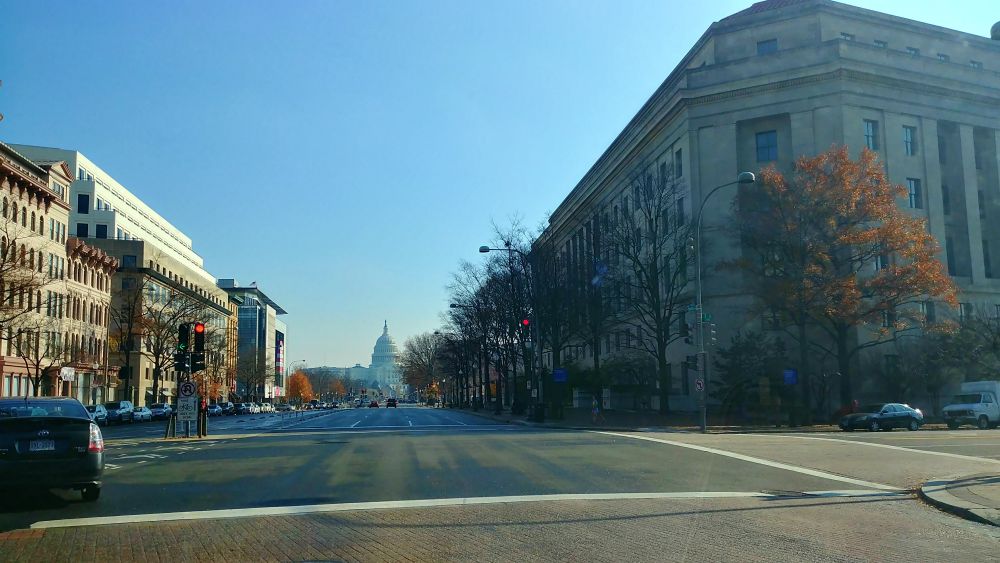
View of U.S. Capitol building, Washington, D.C., December 2017 (Tracy Abeln)
A recent study by the National Community Reinvestment Coalition found that Washington, D.C., experienced the highest "intensity of gentrification" of any city in the U.S. between 2000 and 2013. According to the study, about 40 percent of the city's lower-income neighborhoods experienced gentrification during that period, displacing thousands of residents with lower incomes, including 20,000 black residents.
"There is a great disparity between the haves and have-nots in this region," said Bader. "People don't realize the challenges of the working poor."
The challenge of affording a stable life in the D.C. area is all the more difficult for single mothers.
"It's very, very hard," said Brittney Booze, a former resident of St. Ann's and native to D.C. "I've experienced it; I am experiencing it, but the life skills I've been given through St. Ann's definitely gives me an upper hand on controlling that situation and getting all the resources that I need."
Booze found St. Ann's via a Google search almost three years ago. Homeless, 23-years-old and pregnant, she knew she needed a transitional housing program to find stability for her new baby and was thankful to be accepted into St. Ann's.
"Being pregnant and not really having anywhere to go, St. Ann's was basically a safe haven for me," she said.
What was once an infant asylum during the Civil War — though in a different building — is now a multi-faceted center equipped to provide dozens of teen and homeless mothers with all the resources they need to succeed in a competitive world and region.
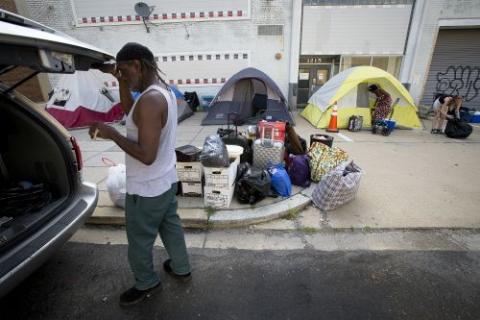
People in Washington pack their belongings June 22, 2017, after police told them they had to move from the sidewalks. (CNS/Tyler Orsburn)
Bader emphasized to NCR that St. Ann's is much more of a "program" than a "shelter." Mothers who live at the center have access to education, employment and mental health counseling; clinical and social work services; and a child care center that is also open to children in the nearby community. St. Ann's also mandates that mothers attend weekly life-skills and parenting classes.
Booze, who lived at St. Ann's for two and a half years and transitioned out with her son this past January, is now training to become a medical assistant, working on launching a podcast, and continuing to practice public speaking — a skill she picked up at the center. She attributes much of her current success to the skills she learned at St. Ann's.
"They equipped us with a lot of life skills — financially and for working," she said.
Bader told NCR that the community feeling at St. Ann's is another key contributor to the success of the mothers who live there; in 2018, 93% of them obtained employment within three months of eligibility. Mothers living at St. Ann's become friends and learn to support one another, Bader said, such as shopping together or babysitting for each other in times of crisis.
Communal living and social events also help create a sense of home for the mothers and children. Booze remembered how meaningful it was that St. Ann's made sure her son had gifts for Christmas, relieving her of a stressful financial burden.
"That was one of the biggest impacts for me," Booze said, "knowing that St. Ann's had my back."
Longterm DC provider
Catholic Charities of the Archdiocese of Washington takes a similarly "holistic approach" to service by offering a wide range of resources meant to empower clients. The Spanish Catholic Center is a good example, in one location, of the comprehensive services Catholic Charities offers community members.
Founded in 1967 to serve the area's Hispanic and Latino immigrant communities, the Spanish Catholic Center is a sort of one-stop-shop to meet any number of its clients' major needs — including housing medical and dental clinics, multiple job-training programs, social and legal services, and a weekly food pantry.

A nurse listens to a client's chest Sept. 16, 2015, at the Spanish Catholic Center, a program of Catholic Charities of the Archdiocese of Washington. (CNS/Reuters/Jonathan Ernst)
Pedestrians walking around northwest D.C.'s Mount Pleasant neighborhood — one of the fastest gentrifying neighborhoods in the entire country — might not notice the center's inconspicuous three-story brick building, tucked into the middle of a quiet residential street.
Melida Chacon, a staff member at the Spanish Catholic Center and longtime Mount Pleasant resident, told NCR that the people the center previously served used to live "in buildings close to the area." As more investment has come into Mount Pleasant, those same people have been displaced and forced to move further away from the center to more affordable areas.
Although some changes in the neighborhood can be seen as improvements, there is a lack of, what Chacon calls, "balance." "There's no space for people who can't afford that much rent," said Chacon.
Nevertheless, in the face of intense changes, the Spanish Catholic Center continues to meet the needs of thousands of poor people, many of them immigrants, every year.
Rodrigo Aguirre, a case manager at the center, said the collection of services the center offers are intended to empower clients and put them on a "path to independence." He said his primary goal is helping clients gain "self-sufficiency" so that they no longer need Catholic Charities services.
Chacon is an example of the positive impact the Spanish Catholic Center has on those it serves. She participated as a student in the center's construction training program in its first ever cohort in 2002. One year later, in 2003, she was hired as an instructor for the same program, a role she has held ever since.
Chacon said that in the early days of the construction program most students were Latino immigrants living in and around Mount Pleasant. As the area around the center changed, Latinos became the minority in the classes, with students coming from many other parts of the world.
"The good thing is they all have the same needs," said Chacon, who immigrated to the U.S. from El Salvador. "If your mission is to help them, that satisfies you — to make a difference in a human being."
Staff members at the Spanish Catholic Center speak as proudly about all of the work Catholic Charities does throughout the archdiocese as they do about their own.
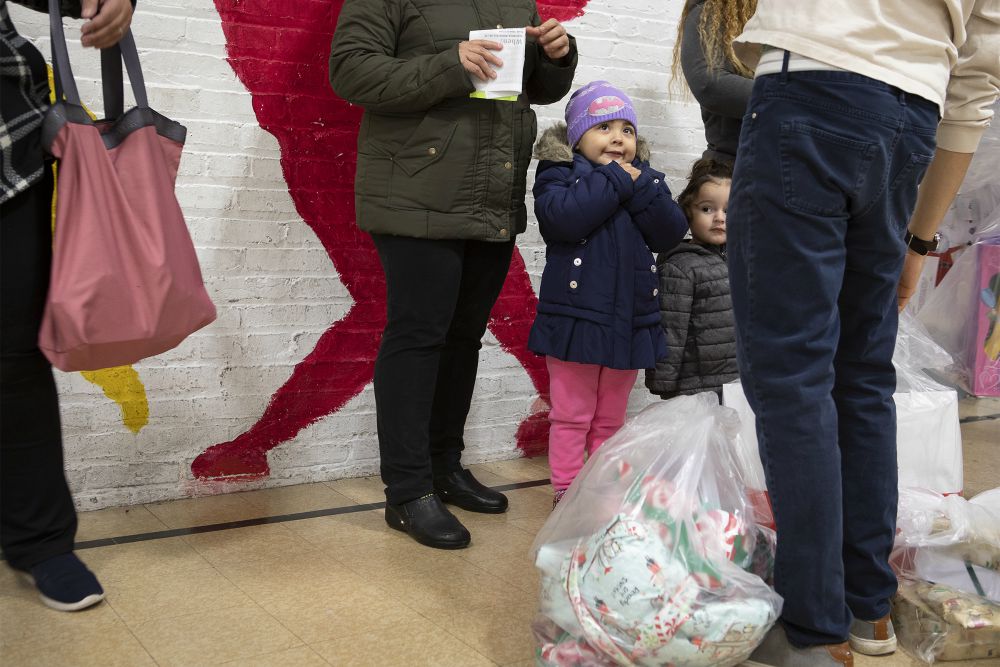
Children wait Dec. 10, 2018, to receive bags of gifts at Sacred Heart School in Washington. The toys were donated to Catholic Charities' Spanish Catholic Center by more than 180 people and will help children and families celebrate Christmas last year. (CNS /Tyler Orsburn)
Inclusive threads
A particular source of pride is the Catholic Charities Health Care Network. The network is run by three women and operates out of a tiny room on the third floor of the Spanish Catholic Center building. The facility may have a humble appearance, but it has served people with the least resources, giving them needed medical care for 35 years.
The network has partnerships with more than 300 specialists and five area hospitals that provide care pro-bono, at no cost to Catholic Charities. Thanks to the network, patients without medical insurance have received expensive and specialized procedures like chemotherapy, heart surgery, and neurosurgery for just $25 paid directly to the volunteer specialists.
Sr. Romana Uzodimma, director of the Health Care Network, said that patients "become our family." "We journey with them," she said. It "doesn't matter what faith, or what background [patients come from], only needs matter."
"We just say yes," said Uzodimma.
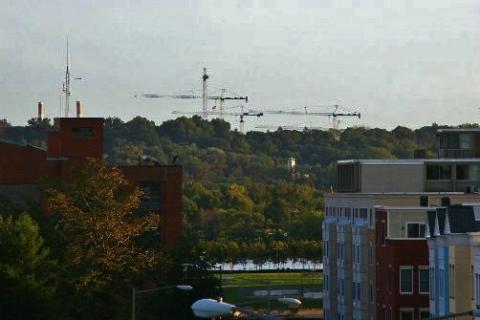
Construction cranes at U.S. Department of Homeland Security headquarters, Dec. 29, 2011 (Flickr/Tim Evanson)
Journeying with people who are poor and relating to those they serve on an intimate personal basis is a common thread across the various Catholic organizations in the archdiocese. For example, Bader lives at St. Ann's facility full time with the mothers in the program, and most of the Spanish Catholic Center's staff are immigrants themselves.
Perhaps the group that best embodies this personal approach is the Missionaries of Charity, the religious order founded by Mother Teresa in 1950 that came to Washington, D.C., in 1988 to care for people living with HIV/AIDS. Over time, as the number of such patients in the city decreased, the sisters who preach simplicity over efficiency showed their own ability to adapt to a changing landscape and switched their focus to the elderly.
The sisters now provide basic care for elderly people who are the "poorest of the poor," according to Sr. Francis Gabriel who helps to run the "Gift of Peace" elderly home in northeast Washington at their convent. The residents who come to the home are completely alone, she said. The sisters — who also live there — hope that their care can help the elderly residents die with the "gift of peace," knowing they are loved and wanted even in their last moments.
"It is not a matter of, 'Yes we can heal and cure,' " said Gabriel. "I think today's society is hungry for God, to be loved and cared for."
The Gift of Peace home sits atop a grassy green hill on the border of Washington, D.C. The sisters and the elderly are separated from their closest neighbors in all directions by hundreds of yards. There is not a single television in the building. For those reasons, you might expect the Missionaries of Charity to be somewhat isolated from the rest of their archdiocesan community. That's not the case.
The sisters are well aware of the good work happening across the archdiocese and see how their work fits in to the broader picture.
She compared the archdiocese to a jigsaw puzzle where each group and "each person has to do their part."
"We are not here to compete, but to complete each other," she said.
Every group has a different set of gifts and skills that they contribute to serving the archdiocese. For the Missionaries of Charity, it is sharing the "tender love of God" with the poor. "Some are the hands of Christ, some are the heart of Christ, some are the mind of Christ," she said. "Every little bit helps."
In a recent profile of the archdiocese in NCR, some local Catholic leaders suggested that when a new archbishop is appointed, he should seek out and encounter "real people at the margins."
Bader echoed this sentiment. She hopes the new leader will continue to support and encourage the many groups working on the ground, as well as make it the mission of the archdiocese "to care for the most vulnerable."
Bader believes that serving others and caring for the poor is what truly unites the church.
"That was Jesus' mandate," she said.
[Jesse Remedios is an NCR Bertelsen intern. His email address is jremedios@ncronline.org.]








